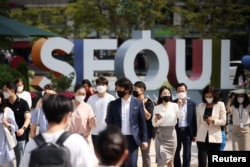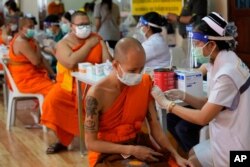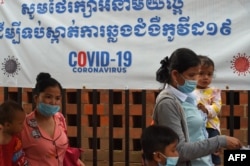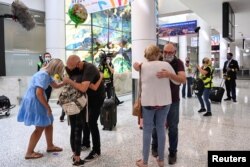SEOUL, SOUTH KOREA —
Asia is finally starting to open up after many nations in the region imposed strict measures to combat the novel coronavirus pandemic.
From Thailand to South Korea to Cambodia, Asian governments are relaxing social distancing rules and in some cases are even starting to welcome foreigners.
The moves come as Asia, once a laggard in COVID-19 vaccinations, speeds up inoculations, helping drive back devastating summer outbreaks driven by the emergence of the more transmissible delta variant.
Asia’s reopening appears more gradual than that of Western countries such as the United States or Britain, where political leaders declared COVID-19 victory only to see cases spike once restrictions were eased.
In many Asian countries, officials warn the moves could be reversed if cases spike. In others, governments are conceding that it may be time to live with the virus.
Here’s a rundown of how Asian-Pacific countries are attempting to emerge from the pandemic:
South Korea
One of the rare countries to avoid both major lockdowns and mass deaths, South Korea has used rapid COVID-19 testing and high-tech contact tracing to quickly extinguish outbreaks, causing only minimal disruptions to daily life.
After reaching its 70% vaccination target, South Korea this month began to open more fully. In Seoul, larger crowds can now gather and nighttime curfews have been lifted for many businesses.
Barring setbacks, all social distancing measures will be dropped at the end of February. However, it’s not clear when immigration restrictions will be eased. Currently, some business trips are allowed, but not tourism.
Japan
Japan has mostly contained the virus while implementing only soft lockdowns.
However, during this summer’s Tokyo Olympics, the country saw its worst COVID-19 wave yet. That wave has now subsided.
With over 70% of its population fully vaccinated, Japan has lifted its semi-lockdowns and now allows larger crowds at sporting events and concerts.
Japan will soon loosen rules for foreign visitors, starting with short-term business travelers who will now only be required to do a three-day quarantine. Tourism is still not allowed.
Thailand
Strict curfews, public gathering restrictions, and a border lockdown successfully contained COVID-19 in Thailand until June, when cases spiked.
While the outbreak is down from its peak, Thailand is still reporting about 10,000 new cases per day. In many areas, tight social distancing remains, including restrictions on the sale of alcohol.
However, starting this month, vaccinated tourists from more than 60 countries can visit parts of Thailand without quarantines, in an effort to revive the country’s crucial tourism sector.
Vaccinations have also picked up, but only 44% of the population is fully vaccinated.
Taiwan
One of the world's COVID-19 standouts, Taiwan has allowed its citizens to live an almost completely normal life while preventing any major outbreaks.
Taiwan had recorded only 12 COVID-19 deaths until May of this year, when it saw its biggest outbreak yet. However, that wave was quickly suppressed, thanks to temporarily enhanced social distancing and rigorous contact tracing.
Only about a third of Taiwanese have been fully vaccinated. But officials have hinted that quarantine requirements for both foreign visitors and returning Taiwanese may be loosened starting around February.
Indonesia
Indonesia was spared the worst of the pandemic until June, when the country saw one of Asia’s most devastating COVID-19 outbreaks. While cases have since plummeted, only less than a third of Indonesians are fully vaccinated.
Officials say the vaccination rate is much higher in the tourist haven of Bali, which this month started accepting vaccinated visitors from 19 countries. However, the mandatory 5-day hotel quarantine appears to be deterring many tourists away so far.
Elsewhere in the country, stricter social distancing guidelines remain in place.
More details: https://ift.tt/2NDFhBt
Malaysia
Malaysia's Delta-driven summer outbreak has receded, thanks in part to a successful vaccine drive. More than 75% of the population is now fully vaccinated, allowing its most intense lockdown measures to be ease.
Fully vaccinated Malaysians can now cross state borders and travel internationally, although they must quarantine for 14 days when they return from overseas. Mask-wearing and other social distancing guidelines are still enforced.
Reports suggest international tourists will start to be welcomed back to the tourist haven of Langkawi as part of a pilot project starting this month.
Cambodia
Like many other Asian countries, Cambodia managed to contain COVID-19 until earlier this year, when it experienced its largest outbreak.
It suppressed that wave using severe lockdowns which prevented individuals from leaving their homes.
Although Cambodia is one of Asia’s poorest countries, it now has one of the region's highest vaccination rates.
The country recently declared it is ready to live with the disease. Starting in late November, Cambodia will welcome vaccinated foreign tourists to three popular beach destinations. Tourists will not be quarantined, but will be required to stay in their initial destinations for at least five days.
Singapore
For most of the pandemic, Singapore pursued a “zero-COVID” strategy. It officially abandoned that approach in June.
Once restrictions were eased, daily cases quickly spiked from double digits to nearly 4,000, prompting the tiny city-state to reimpose some social distancing rules. However, the country’s 80% fully vaccinated rate has helped keep the death rate low.
Singapore currently welcomes vaccinated foreign visitors, including tourists, from an expanding list of countries that now stands at 12.
More details: https://ift.tt/2XK7GLD
Australia
Australia enjoys one of the world's lowest COVID-19 death rates per capita. It accomplished this by quickly sealing its borders and employing strict lockdowns.
However, parts of the country have begun opening. Sydney, the country’s largest city, this month will allow vaccinated residents to host unlimited numbers of people at their homes.
Vaccinated Australians can now travel overseas without needing a quarantine exemption.
But with cases still near an all-time high following a surge earlier this year, many regions still enforce tough social distancing.
Foreigners are still unable to visit.
New Zealand
Until the onset of the Delta variant, New Zealand had employed a zero-COVID strategy, with much success. However, it recently announced it would instead rely on vaccinations to contain the disease.
Even as New Zealand continues to set record highs in daily infections, its overall effort is impressive. The country has recorded just 28 COVID-19 deaths. About 65% of the country is fully vaccinated.
Though it has abandoned its COVID-19 elimination strategy, strict social distancing continues. At times, entire regions are sealed off to isolate specific outbreaks.
Almost no foreign visitors are currently allowed.
Philippines
Citizens in the Philippines have suffered through some of the world’s longest and most stringently enforced lockdowns.
However, officials began loosening those measures in June, apparently in an attempt to shore up a quickly shrinking economy.
Shortly after, the country saw one of Southeast Asia’s worst COVID-19 outbreaks.
Only about a fifth of the country has been fully vaccinated. Officials are prioritizing the vaccination of tourism workers, in hopes of soon welcoming back foreign visitors, who will be taken straight to vacation destinations without quarantines.
Vietnam
Vietnam had effectively prevented the coronavirus from spreading until July. Since then, virtually all of the country’s 22,000 COVID-19 deaths have been reported.
Although only about a quarter of Vietnamese are fully vaccinated, the Delta-driven outbreak has slowed. As infections decline, cities including Ho Chi Minh have loosened their curfews and lockdowns.
Although strict social distancing remains, Vietnam is shifting toward living with the virus. Authorities recently announced that vaccinated foreign tourists can visit five popular destinations without quarantines starting this month.
North Korea
North Korea shut its borders to international trade and visitors in January 2020, before the coronavirus was on the radar of much of the rest of the world. It still insists it has found no COVID-19 infections, although experts widely question that assertion.
Though its trade with China recently picked up, North Korea’s broader lockdown may last a while. The country has refused multiple international offers of vaccines. Leader Kim Jong Un has repeatedly stressed the long-term nature of the pandemic. Last month, the U.N. special rapporteur on North Korean human rights said the country’s “extreme isolation could crystalize and become the new norm."
Hong Kong
Hong Kong, a densely packed territory of over 7 million people, has contained the virus in large part because of its entry quarantine, which is among the world’s strictest. Last month, Hong Kong announced the policy would get even stricter.
For most of the pandemic, arrivals had to undergo a 14-21-day quarantine. However, diplomats, business leaders, and others were able to get exemptions. Those exemptions will now end, as the territory aligns its policy more with mainland China.
Strict social distancing rules, including bans on most public gatherings, are also still enforced. About 60% of Hong Kongers are fully vaccinated.
China
Though much of the rest of Asia is reopening, that’s not the case in China, which still employs a “zero-COVID” strategy.
Nearly two years after the first COVID-19 case was detected in China, the country continues to lock down large areas in response to what many other countries would consider small outbreaks.
Though around three-quarters of the population have been fully vaccinated, Chinese officials insist their approach will not change until the vaccination rate goes higher.
Most foreign visitors remain banned.
Laos
Unlike many of its neighbors in Southeast Asia, Laos recently extended its lockdown measures, in an attempt to slow a growing outbreak.
In many parts of the country, meetings and gatherings of any kind remain prohibited. Travel between provinces is also forbidden in many areas.
Only about 40% of the population has been fully vaccinated.
Papua New Guinea
Though it is unnoticed by much of the rest of the world, this island nation of 9 million is suffering its worst COVID-19 outbreak yet.
Reports suggest many hospitals and morgues are filling up, threatening to overwhelm an already fragile healthcare system.
Although only less than 400 COVID-19 deaths have been reported, there are concerns the figure could be much higher, due to a lack of COVID-19 testing.
Only about 1% of the country has been vaccinated, due in large part to vaccine skepticism, logistical challenges, and supply issues, experts suggest.
"asia" - Google News
November 03, 2021 at 07:43PM
https://ift.tt/3BGCSfK
Asia Cautiously Opens as Delta Wave Subsides - VOA News
"asia" - Google News
https://ift.tt/2YpEquI
https://ift.tt/2WkdbyX
Bagikan Berita Ini























0 Response to "Asia Cautiously Opens as Delta Wave Subsides - VOA News"
Post a Comment